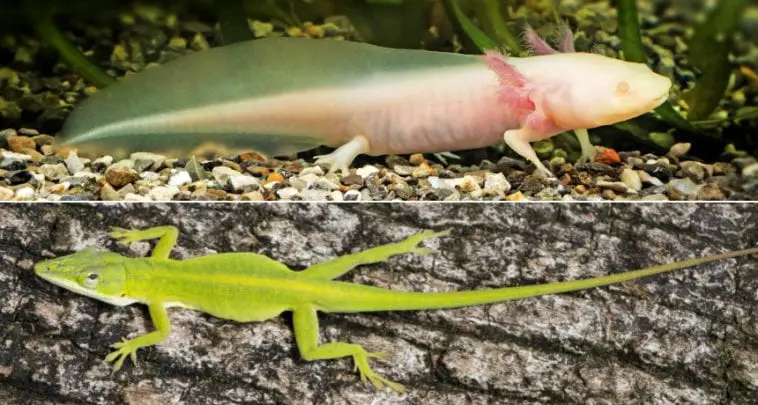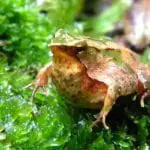When it comes to tails, salamanders have the capability to regenerate a perfect tail. On the other hand, lizards are not able to do so despite having the natural capacity to regrow their tails.
Why is this so?
The changes behind the loss of the regenerative capacity from salamanders and mammals remain elusive to this point. Lizards serve as the intermediary species between salamanders and humans. However, they are only equipped with a limited capability to regenerate their tails. This has resulted in the need to conduct a study that will probe further the mechanisms that are behind the differences in the regenerative patterns between these two species. The results of this study will shed light on the different factors that govern the ability of animals to regenerate, while the loss of this capability will bring us close to creating strategies that will enable mammalian regeneration.
Similarities and Differences
While salamanders and lizards both show the capacity to regenerate amputated tails, the result that is achieved by each of the regenerative processes is different. Salamanders regenerate almost identical versions of their original tails. However, regenerated lizard tails feature morphological differences when compared with their originals.
Some of the differences have something to do with the dorsoventral patterns of the regenerated spinal cord and skeletal tissues. The tissues of regenerated salamander tails feature dorsoventral patterning, while that of lizard tissues do not.
On top of that, the regenerated tails of lizards feature roof plate-associated structures, including the root ganglia. It has been hypothesized that the differences in the neural stem cells that are found in the ependymal of the regenerated spinal cords have something to do with these regenerative outcomes.
Starting the Study

The researchers at the University Of Pittsburgh School Of Medicine initially wanted to find out why amphibians are able to regrow their tails. To do so, they started on a study project. What they eventually found out was quite intriguing and interesting at the same time. The stem cells in the spinal cord of amphibians are important factors that allow salamanders to regenerate an almost perfect version of their tail even when they lose it.
For this reason, the salamander was labeled as the traditional animal model for the process of regeneration. In fact, their capacity to regenerate is not only limited to their tails. They can regenerate a wide range of tissues – heart, brain, limbs, and parts of their eyes.
Taking a close look at the body of salamanders would reveal that they have different classes of molecule types and tissues which are not present in mammals. For this reason, much of what was discovered in salamanders do not apply to humans.
The study continues by transplanting salamander stem cells into the regenerating stump of a gecko. They were trying to see what is stopping the lizard from regenerating its tail perfectly, whether it is the native stem cells or the biochemical environment.
The added salamander stem cells were able to maintain the capacity to differentiate into different types of stem cells, including neurons. However, the lizard stem cells could only turn into glial cells or those that protect neuronal cells. These glial cells do not have the capacity to process the instructions involved in directing feeling and movement, while the neuronal cells do.
Perfect Tail Regeneration – A Salamander Can

With salamanders, the tail that is regenerated is basically the exact copy of what the animal lost, either by accident, predation, and other mishaps. When lizards lose their tail, they can still regrow it, but it is nothing like the original. The regrown tail lacks bone that was once present, the color patterns do not match, and the scales are different.
It is easy to spot a lizard with a regenerated tail. It just does not look right, even looking like an attachment to the body. When you take a closer look at the tail, the tissues are all different. The skeleton is cartilaginous.
It all boils down to the neural stem cells that create the regeneration process of the tails among lizards. They are not real neural stem cells; they found out. This is because they cannot generate the different cell types that are needed in order to recreate the asymmetries of the original spinal cord of the lizards. This further prevents the creation of a bony vertebrate.
It is the spinal cord, which is the regulator of the tail regeneration procedure. These differences between salamander and lizard tails are a result of the differences in the quality of stem cells. It is mainly because of the neural stem cells. As such, they have created the study contract, which says that the differences in the identity of neural stem cells drive the divergent regenerative capacity in salamanders and lizards.
Tail Regeneration in Lizards – Not as Perfect

If the aim is to translate the regeneration study to non-generating species such as humans, lizards are a better model compared with salamanders. This is because they are the closest to mammals in terms of being able to regenerate an appendage. At the same time, they have similar biochemistry and genome.
Other animals, such as fish and frog tadpoles, can also regenerate their tails, with most of the growth at the tip. During the process of regenerating their tails, they turn on genes in a specific process termed as the ‘Wnt pathway,’ which is required in controlling stem cells in many organs, including the hair follicles, brain, and blood vessels. Lizards, however, have a unique pattern in terms of tissue growth, as it is distributed throughout the tail.
Even though lizards can regenerate their tails, they are not exactly the same anymore. Studies have revealed that new tails are different from the original tails. The original one has shorter muscle fibers and vertebrae. The new tail, on the other hand, features a cartilaginous rod with long muscle fibers and pores that span the entire length of the new tail regenerated. These characteristics were not present in the original tail.
The new regenerated tail does not have nerves, which is quite interesting for scientists. As a result, they have speculated that the nerves found in the original stump are grown into the new tail. It has also been suggested by the studies that the regenerated tail becomes less flexible, performing only some of the functions done by the original tail.
Researchers have been mostly interested in the capacity of certain lizards to grow their tails back. They believe that studying more on how lizards regenerate their tails can prove to be of benefit to human beings in the future. With the use of advanced technologies, they continue their attempts in supercharging these lizard genes into the human cells, which may lead to the possibility of regrowth of spinal cords or muscles among humans in the future.
With lizards, one type of cell that is vital for tissue regeneration has been identified. Just like in humans and mice, lizards have satellite cells that grow and develop into skeletal muscles as well as other tissues. With the use of next-generation technologies to sequence the genes during the regeneration, the mystery of what genes are required to regrow tail has been unlocked. By following this process for regeneration in lizards, and harnessing the same genes into human cells, it could be possible to regrow new muscle, cartilage as well as spinal cord in the future. Researchers hope that their findings will be beneficial to the human race in the future.
The Role of the Spinal Cord
Researchers continued looking into the reason why salamanders complete a perfect tail regeneration, while lizards cannot. It has something to do with the spinal cord and the neural stem cells. These cells are the nascent precursors to glia and neurons. Glia is the non-neuronal cells surrounding the neurons. They took some neural stem cells from the salamander, inserting them into the regenerating tail stump of lizards. What they wanted to know is what holds back the process of tail regeneration in the lizard.
It was a surprise to them, knowing that the regenerative processes are still conserved. One observation that they noticed is that the driving regeneration of neural stem cells in lizards is not the real neural stem cells. Even though they have checked some items in their list, they still fall short of a distinct characteristic that defines the identity of the stem cells, the ability to create a diversity of cell types.
This resulted in the explanation of why there is not a perfect tail regeneration among lizards. The neural stem cells cannot produce different cell types that would be required for the recreation of the asymmetries of the spinal cord, which facilitates the development of bony vertebrae in turn.
In short, it is the spinal cord that serves as the master regulator of the tail regeneration process. These differences between salamander and lizard tails are a result of the differences in stem cell quality. It is because of the neural stem cells.



